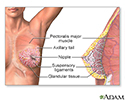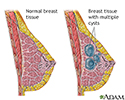Fibrocystic breast disease
Fibrocystic breast disease; Mammary dysplasia; Diffuse cystic mastopathy; Benign breast disease; Glandular breast changes; Cystic changes; Chronic cystic mastitis; Breast lump - fibrocystic
Fibrocystic breast disease is a common way to describe painful, lumpy breasts.
Causes
The exact cause of the condition is not known. Hormones made in the ovaries may make a woman's breasts feel swollen, lumpy, or painful before or during menstruation each month.
Up to half of women have this condition at some time during their life. It is most common between the ages of 20 and 45. It is rare in women after menopause unless they are taking estrogen.
Symptoms
Symptoms are more often worse right before your menstrual period. They tend to get better after your period starts.
If you have heavy, irregular periods, your symptoms may be worse. If you take birth control pills, you may have fewer symptoms. In most cases, symptoms get better after menopause.
Symptoms may include:
- Pain or discomfort in both breasts
- Pain that commonly comes and goes with your period, but may last through the whole month
- Breasts that feel full, swollen, or heavy
- Pain or discomfort under the arms
- Thick or lumpy breasts
You may have a lump in the same area of the breast that becomes larger before each period and shrinks afterward. This type of lump moves when it is pushed with your fingers. It does not feel stuck or fixed to the tissue around it. This type of lump is common with fibrocystic breasts.
Exams and Tests
Your health care provider will examine you. This will include a breast exam. Tell your provider if you have noticed any breast changes.
If you are over 40, ask your provider how often you should have a mammogram to screen for breast cancer. For women under 35, a breast ultrasound may be used to look more closely at breast tissue.
Mammogram
A mammogram is an x-ray picture of the breasts. It is used to find breast tumors and cancer.

Breast ultrasound
Breast ultrasound is a test that uses sound waves to examine the breasts.

You may need further tests if a lump was found during a breast exam or your mammogram result was abnormal. Another mammogram and breast ultrasound may be done.
Treatment
Women who have no symptoms or only mild symptoms DO NOT need treatment.
Your provider may recommend the following self-care measures:
- Take over-the-counter medicine, such as acetaminophen or ibuprofen for pain
- Apply heat or ice on the breast
- Wear a well-fitting bra or a sports bra
Some women believe that eating less fat, caffeine, or chocolate helps with their symptoms. There is no evidence that these measures help.
Vitamin E, thiamine, magnesium, and evening primrose oil are not harmful in most cases. Studies have not shown these to be helpful. Talk with your provider before taking any medicine or supplement.
For more severe symptoms, your provider may prescribe hormones, such as birth control pills or other medicine. Take the medicine exactly as instructed. Be sure to let your provider know if you have side effects from the medicine.
Surgery is never done to treat this condition. But if you have a lump that is suspicious, your provider may recommend a biopsy . In this test, a small amount of tissue is removed from the lump and examined under a microscope.
Biopsy
A biopsy is the removal of a small piece of tissue for laboratory examination.
Outlook (Prognosis)
If your breast exams and mammograms are normal, you DO NOT need to worry about your symptoms. Fibrocystic breast changes DO NOT increase your risk of breast cancer. Symptoms usually improve after menopause.
When to Contact a Medical Professional
Call your provider if you:
-
You find new or different lumps during your
breast self-exam
.
Breast self-exam
A breast self-exam is a check-up a woman does at home to look for changes or problems in the breast tissue. Many women feel that doing this is impor...
 ImageRead Article Now Book Mark Article
ImageRead Article Now Book Mark Article - You have new discharge from the nipple or any discharge that is bloody or clear.
- You have redness or puckering of the skin, or flattening or indentation of the nipple.
References
Alvero R. Fibrocystic breast disease. In: Ferri FF, ed. Ferri's Clinical Advisor 2017 . Philadelphia, PA: Elsevier; 2017:474-474.
Bope ET, Kellerman RD. Women's health. In: Bope ET, Kellerman RD, eds. Conn's Current Therapy 2016 . Philadelphia, PA: Elsevier; 2016:chap 17.
Hunt KK, Mittendorf EA. Diseases of the breast. In: Townsend CM Jr, Beauchamp RD, Evers BM, Mattox KL, eds. Sabiston Textbook of Surgery . 20th ed. Philadelphia, PA: Elsevier; 2017:chap 34.
The American College of Obstetricians and Gynecologists. Benign breast problems and conditions. ACOG Web site. www.acog.org/Patients/FAQs/Benign-Breast-Problems-and-Conditions . Accessed December 02, 2016.
-
Female Breast - illustration
The female breast is either of two mammary glands (organs of milk secretion) on the chest.
Female Breast
illustration
-
Fibrocystic breast disease - illustration
Fibrocystic breast disease is a common and benign change within the breast characterized by a dense irregular and bumpy consistency in the breast tissue. Mammography or biopsy may be needed to rule out other disorders.
Fibrocystic breast disease
illustration
Review Date: 11/11/2016



